#pasteurized camel milk
Explore tagged Tumblr posts
Text
camel milk is naturally low in lactose and camels can be raised in arid regions that are unsuitable for agriculture or cattle ranching so there’s some decent reasons to get into camel ranching and camel milk. but you have to pasteurize it.
13 notes
·
View notes
Text
Why cheese production and consumption lag in Brazil
Global dairy event highlights environmental challenges and Brazil’s high-quality cheeses

Last month, the International Dairy Federation hosted its guests with a cheese and wine party at the Louvre’s atrium, beneath the pyramid, followed by a private museum tour in Paris. The federation organizes the industry’s most significant event, the Global Dairy Summit, which brought together representatives from 62 countries, with India and China having the largest delegations. Brazil was also present, with speakers, farmers, and companies exploring the market.
On the reception night, the Louvre seemed almost empty compared to regular days when it’s packed with crowds. Difficult-to-access artworks like the “Mona Lisa” and the “Winged Victory of Samothrace,” the headless Greek goddess poised atop a staircase, were visible. The atrium featured islands with various cheese types, showcasing the power and diversity of France’s industry.
In 1962, a famous quote from General Charles De Gaulle, former president of France, humorously said: “How can anyone run a country with 258 varieties of cheese?” Though renowned, the quote is now outdated. “I’ve listed 3,390 types of cheese in France so far, and I believe I’ll reach 5,000,” François Robin, a consultant, expert, and award recipient of “Meilleur Ouvrier de France,” told Valor. He is a key figure in the cheese world.
“I started this list as a challenge, aiming for a world record with a friend,” he said with humor, estimating around 10,000 cheese varieties worldwide, whether made from raw or pasteurized milk of cows, goats, sheep, buffalo, or camels. “My greatest thrill is rare cheeses, but I don’t want to impose models. It’s already challenging enough to raise animals and produce dairy, so I respect all producers without a militant viewpoint,” he said. “I know some producers wouldn’t like to see their cheeses in a hamburger, but that’s a matter of personal taste.”
Continue reading.
1 note
·
View note
Text
Benefits of Camel Milk- Crimson Publishers

Benefits of Camel Milk- Crimson Publishers
Camel milk is rich in many nutrients that are important for overall health. It has been shown to lower blood sugar and improve insulin sensitivity in people with both type 1 and type 2 diabetes. The milk contains insulin-like proteins, which may be responsible for its antidiabetic activity. The milk contains compounds that appear to fight various disease-causing organisms. The two main active components in camel milk are lactoferrin and immunoglobulins, proteins that may give camel milk its immune-boosting properties. Lactoferrin has antibacterial, antifungal, antiviral, anti-inflammatory, and antioxidant properties. Camel milk has been studied for its effects on behavioral conditions in children, and people suggest that it may aid those with autism. It’s also studied for its effects on behavioral conditions in children, and people suggest that it may aid those with autism. The disadvantage of camel milk is more expensive, may not be pasteurized and may pose ethical concerns.
For more open access journals in crimson publishers Please click on link: https://crimsonpublishers.com
For more articles on Research in Medical & Engineering Sciences Please click on link: https://crimsonpublishers.com/rmes/
#crimson biomedical engineering#biomedical engineering#crimson publishers#crimson-biomedical#crimson publishers journals#biomaterials
0 notes
Text
Camel Milk Market Unidentified Segments - The Biggest Opportunity Of 2022
Latest edition released by AMA on Global Camel Milk Market to regulate the balance of demand and supply. This intelligence report on Camel Milk includes Investigation of past progress, ongoing market scenarios, and future prospects. Data True to market on the products, strategies and market share of leading companies of this particular market are mentioned. It’s a 360-degree overview of the global market’s competitive landscape. The report further predicts the size and valuation of the global market during the forecast period. Some of the key players profiled in the study are
Camelicious (United Arab Emirates)
Al Ain Dairy (United Arab Emirates)
Desert Farms (United States)
Vital Camel Milk (Kenya)
Tiviski Dairy
Camilk Dairy (Australia)
Camel Dairy Farm Smits (Netherlands)
Camel Milk Co (Australia)
Camel Milk (South Africa)
Amul (India)
Camel milk contains high concentrations of potassium, magnesium, copper, sodium, zinc, iron, B vitamins, vitamins C. It also contains protective proteins such as Lysozymes, Lactoferrin, Peptidoglycan recognition protein, and NAGase. According to the Australian camel industry association, it has five times the vitamin C and 10 times the iron of cow’s milk. Camel milk also comes in raw, pasteurized and powdered form which is used to make a product like soap. Market Trends: Increasing Demand in United States as Alternative Milk for Health Benefits
Opportunities: Great Opportunity for Camel Dairies in Australia Because Of Its Incredible Reputation in Food Quality Safety Standards
Market Drivers: Increasing Awareness of Health Benefits
Emerging Countries for Camel Milk
Investments to Expand Australian Camel Milk Production
Challenges:
Presented By
AMA Research & Media LLP
0 notes
Text
"These are more or less experimental laboratory conditions. And we think that mechanical pasteurization in dairy farming will probably be more effective than what we do," said Vincent Munster, chief of the virus ecology unit at the National Institute of Allergy and Infectious Diseases.
Munster's lab in Montana has done work for years studying the ability of viruses to stay infectious in various conditions, including previous work pasteurizing pathogens in milk, like from an outbreak of coronaviruses in camels from Jordan.
In this study, they looked at two approaches of pasteurization, tested on milk with concentrations of H5N1 they added at levels similar to what has been seen from some highly infectious cows.
One pasteurization method they looked at heated milk to 72 degrees Celsius (about 161 degrees Fahrenheit) for 15 seconds, similar to the "high temperature short time" method that is used widely across the dairy industry. That yielded milk with what Munster said still had "minute amounts of infectious virus."
"You're really talking about like 10 virus particles, whereas the initial starting dose would be something like 10 million or 100 million virus particles," said Munster.
He also pointed to differences between the lab study and real-world industry practices which give commercial milk pasteurization a step up against the virus.
"There is an initial period in the dairy milk pasteurization that the milk needs to get from let's say 4 degrees to 72 degrees [Celsius]. And obviously once it starts hitting around 56 degrees, it already starts inactivating the virus," he said.
The second pasteurization approach — a half hour at 63 degrees Celsius — was more effective. Infectious virus was undetectable within minutes, long before pasteurization was over.
"Pasteurization methods were developed to actually reduce the amount of viable bacteria in milk to prolong fridge life, so to speak. And they're not necessarily initially designed to inactivate viruses," said Munster.
[...]
"Fortunately, they do actually inactivate viruses very well. But I think the focus point should be two fold: making sure that pasteurization is up to the task we're asking from it, and the data suggests that it is, but also that we should minimize any H5N1 positive milk actually coming into these dairy pasteurization," he said.
31 notes
·
View notes
Text
Why Buy Pasteurized Camel Milk? Raw Vs Pasteurized Camel Milk
The comparison between raw and pasteurized camel milk can bring forth major difference in opinion. While both type of camel milk has health benefits, pasteurized camel milk only gives you the positive effects.
In today’s COVID situation, boosting your immunity and maintaining good health is a must. Consuming right nutrition is crucial to deal with the situation. Drinking camel milk can help you stay strong. However, people often get confused whether to consume raw camel milk or pasteurized camel milk. When comparing raw camel milk versus pasteurized camel milk, interest lies within the difference in nutritional value. While most people think that raw milk maintains more vitamins and minerals, various sources will tell you otherwise.

After a quick research of the internet, you might fall victim to thinking pasteurized camel milk isn’t healthy. Sometimes, you can find the opinion of most camel milk consumers and they think that raw milk is the only way to experience the highly sought-after benefits. But when it comes to evidence-based researches, you will get to know the actual benefits of pasteurized camel milk. According to researchers heating the camel milk actually doesn’t eliminate all the wonderful benefits you’re trying to gain.
Believe it or not pasteurization can actually enhance your camel milk experience. You can search camel milk for sale and buy pasteurized camel milk due to its benefits. Much like any other natural products, consuming camel milk raw can actually bring negative effects in addition to positive. Given it is completely untreated, raw milk not only contains healthy bacteria, but also bacteria that can make you sick. In fact, it can give you severe allergy if you are lactose intolerant. On the other hand, consuming it pasteurized gives you an extra level of prevention against bad bacteria.
#Camel Milk for Sale#Camel Milk in Gurgaon#Camel Milk Delhi#Camel Milk in Delhi#Camel Milk#Camel Milk Benefits#Best Camel Milk#Buy Online Camel Milk#Buy Camel Milk Near Me#Buy Camel Milk Online in India#Pasteurized Camel Milk#Frozen Camel Milk#Freeze Dried Camel Milk#Camel Milk Online Shopping#Camel Milk Products#Camel Milk Products in India#Camel Milk Autism#Camel Milk Nutrition#Camel Milk Vs Cow Milk#Camel Milk Benifit#Camel Milk Diabetes Treatment#Camel Milk Autoimmune Disease#Camel Milk for Infants#Camel Milk for Kids#Camel Milk Nutrition Facts#Camel Milk Facts#Camel Milk Good for Sex#Camel Milk Health Benefits#Camel Milk Benefits for Health#Camel Milk Benefits for Liver
1 note
·
View note
Text
Holy Yogurt, Batman!
Yogurt can be made at home – and I tend to forget this. Or am I intimidated by my instant pot? (A little of both.) It’s probably more cost effective and will be a tad healthier. Even though I eat plain, Evan gets vanilla – that changed when I incubated my first batch of yogurt in my kitchen.
Yogurt is what is the fermentation of milk from bacteria known as yogurt cultures. Calling it fermented milk isn’t marketing friendly, and therefore was called by the ancient Greeks: oxygala. “Oxi” meaning sour, and “gala” meaning milk. Written about by Greek physician, Aelius Galenus, and Roman author, Pliny the Elder, the earliest yogurts were enjoyed much like we do today – with a touch of honey. Seen throughout cultures from Greeks, Turks, and Russia – with a variety of milks like water buffalo, camels, and goats – and a myriad of flavors like mustard seeds and cinnamon in Mughal Indian Empire – today’s yogurt sold in the U.S. would be unrecognizable. Companies like Dannon and Colombo made yogurt what it is today for our store shelves. And what happened to Colombo? It was bought out by General Mills in 1993, then transitioned to focus on Yoplait.
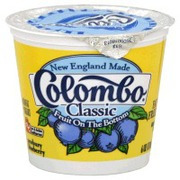
Credit: Fooducate.com
To sweeten plain, unadulterated yogurt for American palates, Colombo Yogurt added fruit preserves to the bottom creating the “fruit on the bottom” craze. This idea alone brought in more than $1 million dollars per year. The yogurt industry has blossomed with different styles like Icelandic, Lassi, Probiotic Yogurt Drinks – and what I’m interested in making myself – Lactose Intolerant Yogurt. According to the package of live cultures it can be made with dairy free milk! I’ll try that one later – right now, let’s make Instant Pot Yogurt.
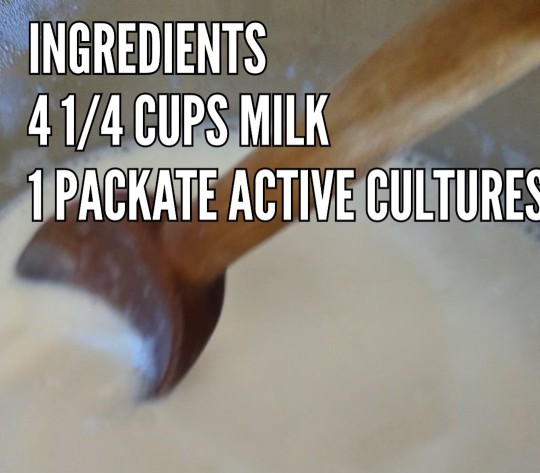
Before adding the milk and cultures to the pot and smashing that YOGURT button, the milk first needs to be pasteurized. To do that, set the sauté and let the milk warm up to around 180 ͦ Fahrenheit (82 ͦ Celsius).
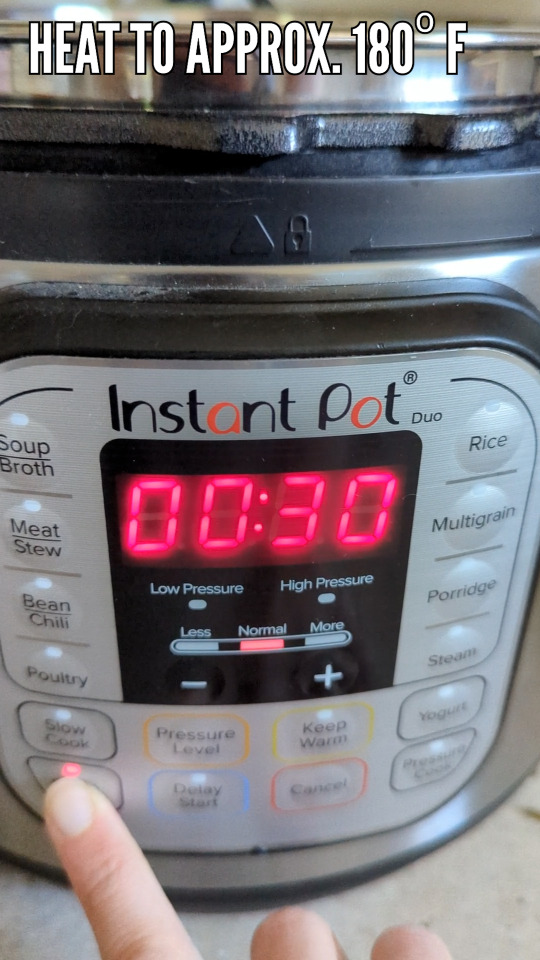
After the milk has reached the necessary temperature, fill the skink with cold water, and cool the pasteurized milk to around 116 ͦ Fahrenheit (46 ͦ Celsius) so the cultures don’t immediately die when added. Stir to combine the active cultures, cover the instant pot, then finally slap that YOGURT button.

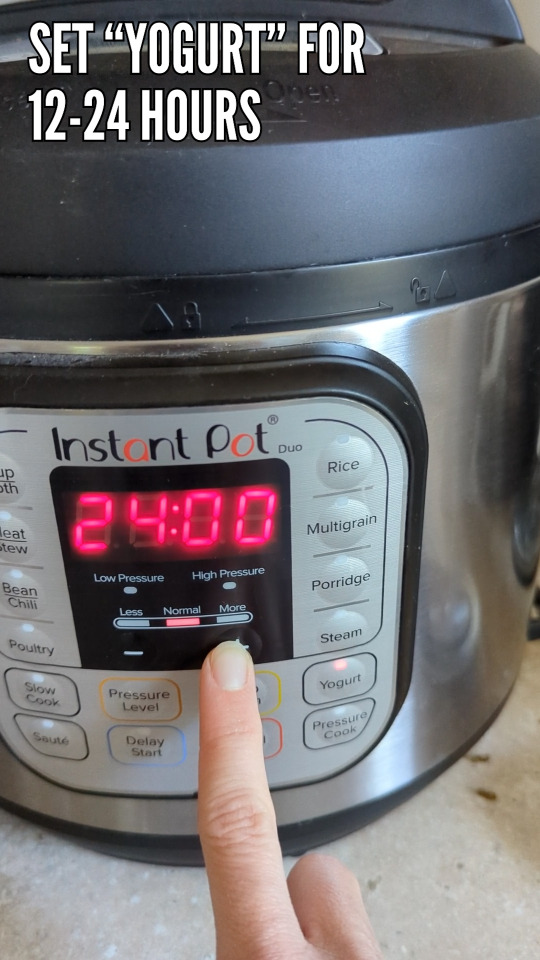
You can choose to incubate this from 12 to 24 hours, I did mine at 24 hours and daaaaamn did this turn out better than expected. Even just after the reveal, I found thick Greek style yogurt like described by Galenus and Pliny the Elder.
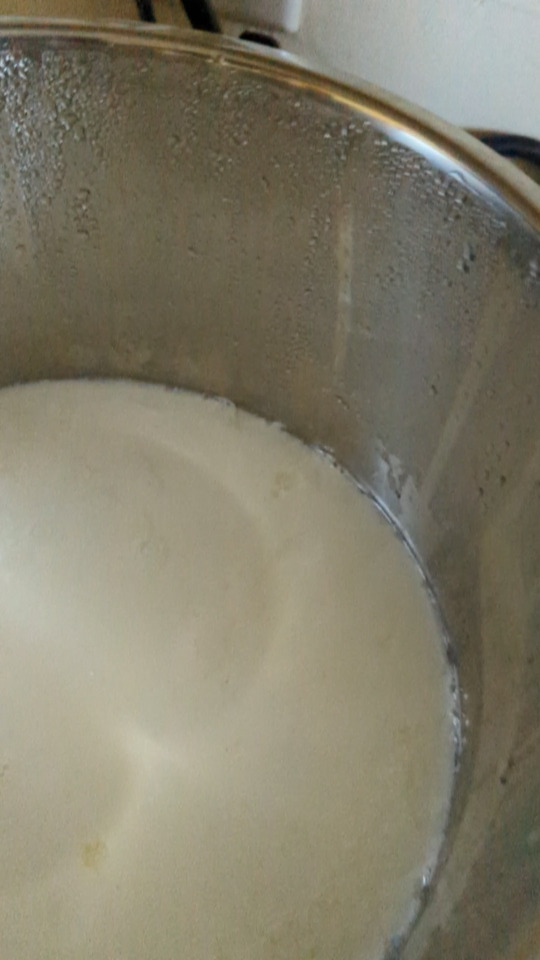
To strain and keep that Greek style, you can invest in cheese cloth and a hook to drip the whey out. Or if you’re creative like me: a metal strainer and coffee filters work just fine! I had these left over from making snowflakes for my Annual Ugly Sweater Party – and finally have a new use for them! Layer a few filters around the strainer, and pour your yogurty goodness on in. It might be more practical to spoon in at first to create less mess, but when filming and cooking – both hands need to be used for the cooking.
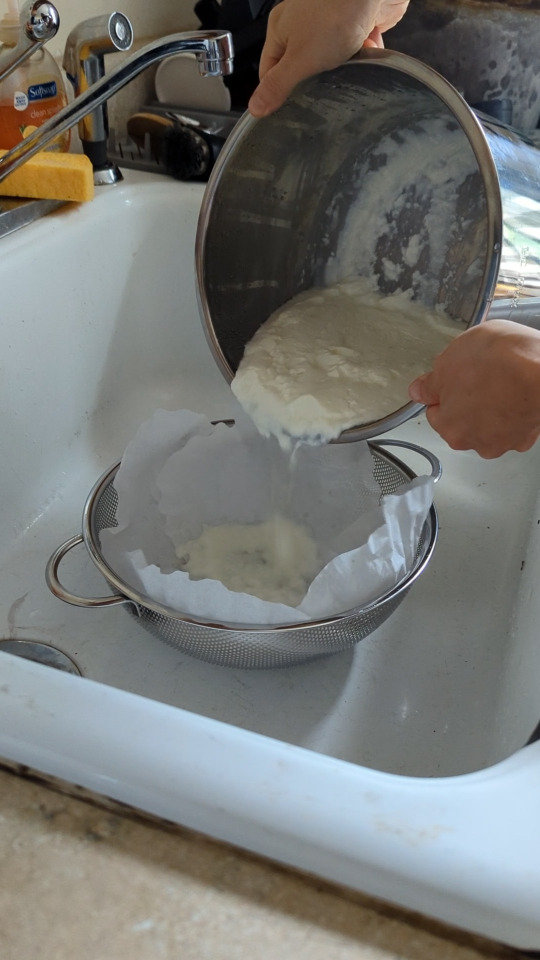
Set the strainer back over the pot used from incubation, and finish draining the whey. I let mine sit a total of 2 hours (cause I’m impatient!), but for extra thick goodness – 4 hours will do the trick. Then scoop out to store or eat straight away!
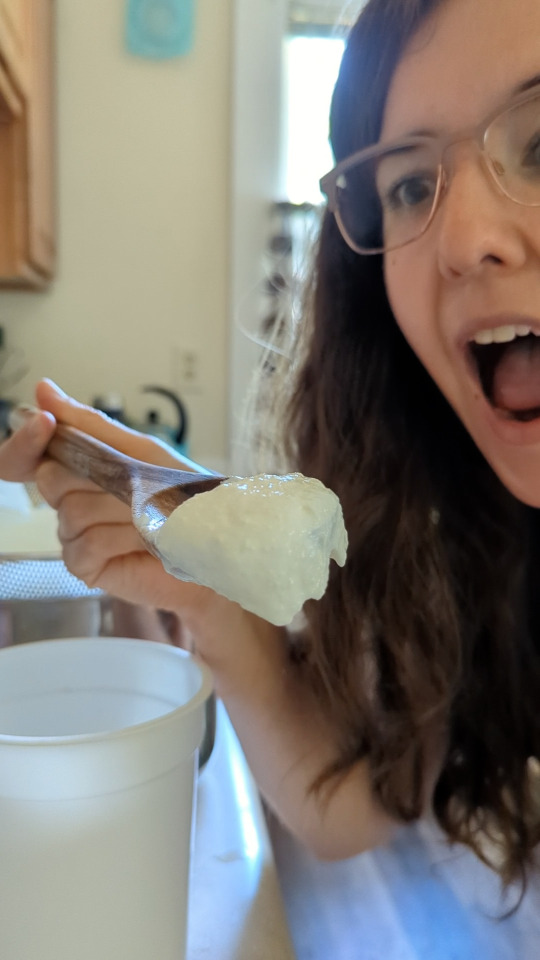
“Yogurt History”, Wikipedia: https://en.wikipedia.org/wiki/Yogurt#History
“Colombo Yogurt”, Wikipedia: https://en.wikipedia.org/wiki/Colombo_Yogurt
“The Home Cooking Survival Guide for Your Busy Work Week”, Pro Home Cooks, YouTube: https://www.youtube.com/watch?v=0boZvBnzQzc
Yogurt Cultures: https://www.amazon.com/gp/product/B00XQHND6M/ref=as_li_tl?ie=UTF8&camp=1789&creative=9325&creativeASIN=B00XQHND6M&linkCode=as2&tag=broth0b5-20&linkId=935dbc1465ae128c96c4add9b5fff0a2
#instant pot#yogurt#instant pot yogurt#how to make yogurt#yogurt at home#homemade yogurt#youtube#cooking#sweetly savory#sweetly savory kathleen#inspiration#tasty#breakfast#food#homemade
2 notes
·
View notes
Photo








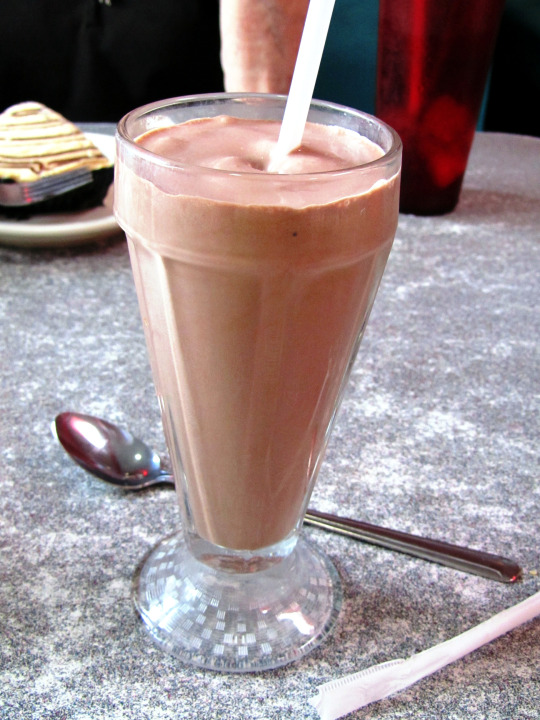

National Milk Day
National Milk Day on January 11 commemorates the day that many think the first milk deliveries in glass bottles began in the United States. Alexander Campbell of the New York Dairy Company professed to the New York State Senate that his company was the first to make these deliveries in 1878.
Here is some milk trivia that you can share with your family and friends:
— The United States and Australia are the world’s largest exporters of milk and milk products.
— Throughout the world, there are more than 6 billion consumers of milk and milk products.
— In the Middle Ages, milk was called the virtuous white liquor because alcoholic beverages were more reliable than water.
— 1863 – French chemist and biologist Louis Pasteur invented pasteurization, a method of killing harmful bacteria in beverages and food products.
— 1884 – American Doctor Hervey Thatcher of New York City, developed the first modern glass milk bottle, called ‘Thatcher’s Common Sense Milk Jar,’ which was sealed with a waxed paper disk. Later, in 1932, plastic-coated paper milk cartons were introduced commercially as a consequence of their invention by Victor W. Farris.
— The females of all mammal species can by definition produce milk, but cow milk dominates commercial production. In 2011, FAO estimates 85% of all milk worldwide was produced from cows.
— Aside from cattle, many kinds of livestock provide milk used by humans for dairy products. These animals include buffalo, goat, sheep, camel, donkey, horse, reindeer and yak.
— Milk is processed into a variety of dairy products such as cream, butter, yogurt, kefir, ice cream and cheese.
— Modern industrial processes use milk to produce casein, whey protein, lactose, condensed milk, powdered milk and many other food-additive and industrial products.
— World Milk Day is celebrated on June 1.
HISTORY
In 1915, The International Association of Milk Inspectors submitted a request to Congress in October of 1915 for a resolution naming an observance of National Milk Day. A date was not suggested in their request. We have no record that the incoming Congress ever presented a resolution for National Milk Day, nor did incoming President Woodrow Wilson ever declare the day.
Source
#National Milk Day#Princess cake#Budapest Roll#Sweden#Germany#travel#bakery#restaurant#Schweden Becher#ice cream#whipped cream#dessert#food#drink#Strawberry Milkshake#Chocolate Banana Shake#Braunvieh#Caramel Cow Shake#Berries&Cream#cattle#cow#LUGA#Switzerland#Swiss Brown#animal#original photography#11 January#NationalMilkDay
5 notes
·
View notes
Text
Fresh Camel Milk And Their Common Myths
The study found that adults who consumed the maximum amount of dairy products lost just short of stone in weight in the six-month stage, while those who only ate low levels of dairy products dropped just half a stone after two years. The study subjects completed surveys about how much food, including milk they consumed on a regular basis. The foods regarded as dairy for the study included low fat and regular milk, flavoured milk, yoghurt, and hard cheeses. Overweight subjects had reduced amounts of vitamin D in their blood once the study began, but the levels went up when you shed the most weight. The greater the amount of vitamin D found in the bloodstream, the bigger the reduction of weight. Are you hunting for pasteurized camel milk? Check out the previously talked about website.
The researchers conclude that both higher calcium intake from milk and increased blood levels of vitamin D are linked to increased diet-induced weight reduction. Just how that occurs is still up for debate. Vitamin D is the nutrient given the label of the "sunshine" vitamin as the body is able to make it after being out in natural sunlight for twenty minutes or so. The nutrient can be found naturally in some foods and added to others. Deficiencies in vitamin d have been connected to a lot of health issues such as heart disease and some forms of cancer. Bringing those levels up appears like it may be helpful for weight loss. Some experts think that milk is a good source of this vitamin and might be replacing other drink choices that might be higher in calories.
Milk is also loaded with protein and nine different nutrients so that it's a fantastic way to fill any gaps that might be opened when you begin cutting calories. It's important to not forget it might not be the dairy enhancing the weight loss, but instead what the participants aren't eating that's assisting with weight loss. For instance, if you are drinking more milk, you're not drinking sugar-sweetened beverages. Another possibility? Since vitamin D is made when we are out on sunlight, maybe those with higher levels were outside more often... perhaps exercising? While some diet experts aren't sold on the idea that the benefits of drinking milk include being a weight loss aid, they do believe it can be a great tasting, the nutritious choice that offers useful nutrients with a low-calorie count instead of unwelcome substances like sugar, sodium and bad fats. Also important to know, elevated levels of milk consumption have been associated with increased risks for certain cancers. Drink wisely.
0 notes
Text
The Effect of Microwaves on the Survivability of Brucella Microorganisms in Infected Cattle Milk

Abstract
This study was carried out to investigate the effect of microwave radiation on the viability of Brucella melitensis in contaminated cattle milk through establishing a correlation between milk volumes, microwave exposure time, measured Celsius temperature and viable counts of B. melitensis in inoculated milk. Microwave appliances were used in houses and many food stores in Egyptand worldwide, for warming milk that processed for human consumption. Microwave heating was performed using a household electronic microwave oven (Kenwood MW 579, a frequency of 2,450 MHz, and power of 900W). Brucella-free milk is inoculated with B. melitensis in a dose of (1.3 X 108 CFU / ml) and samples are divided into 100 ml and 200 ml volumes and maintained at room temperature (22 °C ± 3°C) or refrigeration temperature (5 ºC ± 2 ºC) prior to microwave exposure. Microwave radiations with full power (P = 100) eliminate B. melitensis in 100 ml milk samples kept at room temperature for 80 seconds with measured temperature reached (82 °C) and eliminated Brucellae in 200 ml milk samples in 100 seconds with measured temperature of (78 °C). While in 100 ml refrigerated milk kept at (5 °C ± 2) that exposed to 30 % of the microwave`s power (P = 30) Brucella organisms still viable till 5 minutes and the organisms inactivated at 6 minutes with the measured temperature reached (75 °C). It was found that the warming program of the microwave either in 120 ml inoculated milk for 1 minute or 240 ml milk samples for 2 minutes, Brucella organisms are still viable at counts of (7.1 x 104 and 8.3 x 103 CFU/ml), respectively and considered as a potential source of human infection. In conclusion, the warming microwave program is proved to be unfit to eliminate B. melitensis from contaminated cattle milk.
Keywords: Brucella melitensis Viability Microwaves Milk
Introduction
Brucellosis is a classical zoonosis of worldwide public health and economic importance. Infected animals are the main sources of human infection. The disease frequently transmitted to man by direct or indirect contact with infected animals or their products. Brucellosis infects people of all age groups and of both sexes [1]. Although there have been great efforts exerted in controlling the disease in many countries, there still remain regions where the infection persists in domestic animals and human populations. There are only a few countries in the world that are officially declared free of the disease although they still have human brucellosis due to returning citizens from endemic countries [1].
Milk is a palatable highly nutritious fluid and many people have the custom of drinking milk or add it to their beverages or food. The global per capita dairy consumption of cattle milk was recently estimated in 2015 to be 111.3 kg per year. It was also estimated that the consumption of milk in developing countries is expected to increase in the coming years [2]. Milk produced from infected cattle, sheep, goats and camels, is frequently contaminated with Brucella pathogens and is considered a potential hazard as it contains large numbers of organisms. Tourists or business travelers to endemic areas may acquire brucellosis, usually by consumption of un-heat-treated milk, when visiting countries with known status of animal Brucellosis. Many heat treatment procedures including pasteurization and sterilization were employed for inactivation of pathogenic bacteria and rendering milk fit for human consumption. However, these thermal procedures have got some limitations by way of partial destruction of heat labile nutrients that affects the quality of milk, and sensory attributes [3].
Microwaves are described as they are electromagnetic radio waves that are within a frequency band ranged between 300 MHz to 300 GHz. Microwave heating refers to dielectric heating due to polarization effects at a selected frequency band in a nonconductor. Microwave heating in food beverages occurs due to coupling ofelectrical energy from an electromagnetic field in a microwave cavity with the food and its subsequent dissipation within food product. This results in a sharp increase in temperature within the product. Microwave heating of milk has advantages over other conventional heat treatments due to its rapid increase in temperature, short time duration and it overcome the limitation imposed by the slow thermal diffusion process of conventional heating [4].
The application of microwave heating to pasteurize milk has been well studied and has been a commercial practice for quite a long time. The success of microwave heating of milk is based on established conditions that provide the desired degree of safety with minimum product quality degradation. Since the first reported study on the use of a microwave system for pasteurization of milk [5], several studies on microwave heating of milk have been carried out. The majority of these microwave-based studies have been used to investigate the possibility of shelf-life enhancement of pasteurized milk, application of microwave energy to inactivate milk pathogens, assess the influence on the milk nutrients or the non-uniform temperature distribution during the microwave treatment [6]. The application of microwave energy in bovine milk proved to inactivate Streptococcus faecalis, Yersinia enterocolitica, Campylobacter jejuni, and Listeria monocytogenes [7]. Up to the available literature, the effect of microwaves on the viability of Brucella microorganisms in milk was not yet studied. The aim of this study is to investigate the effect of the microwave radiation on the viability of Brucella melitensis in cow milk through establishing a correlation between milk volumes, exposure time and viable count of Brucella in milk, in a trial to check the efficiency of microwave to render Brucella infected milk safe for human consumption.
Materials and Methods
Preparation of Brucella strain
Brucella melitensis was selected to run the current experiment on the basis that this strain is the common Brucella strain isolated from animals and man in Egypt and most Mediterranean countries [8]. The local strain was isolated from stomach contents of aborted ewe foetus. The organism was subjected to culture identification methods using; monospecific serum (A & M), lysis by Tiblizi and IZ Brucella phages and growth on thionin and basic fuchsine dyes. All biotyping methods were done parallel with and in comparison, with Brucella melitensis reference strain (Ether strain) obtained from NVSL, DBL, USDA. The pure Brucella strain was incubated at 37 oC for 72 h in tryptose soy agar (TSA) medium (Oxide). The experiment was performed in various times, fixed initial bacterial concentration and different Watts power (300 w and full power 900 w) to determine the effect of microwave radiation on viable Brucella organisms using viable colony counting methods.
Inoculation of Milk
Cow milk was aseptically obtained from Brucella free dairy herd, cooled at 4 °C and sent to the lab as soon as possible. Milk wasinoculated with fresh Brucella culture using a loopful of culture suspended in 9 ml of 0.85% (w/v) sterile saline solution and final density was adjusted to MacFarland 0.5. The final concentrations of the organisms were estimated through viable bacterial count of the inoculated milk.
Microwave Heating
Microwave heating was performed using household electronic microwave oven (Kenwood MW 579, a frequency of 2,450 MHz, and power of 900W). Inoculated milk divided into 100 ml and 200 ml volumes and maintained at room temperature (22 C ± 3C). Microwave was used at high power for heating the inoculated milk. To study the effect of warming temperature on the viability of Brucella in milk, a warming program were applied, using another volumes of 120 ml and 240 ml of inoculated milk were microwaved for 60 sec and 120 sec, respectively; according to the warming program listed in the instruction manual of the manufacture company. Just after microwave radiation, the temperature of the inoculated milk was taken using certified calibrated thermometer (ISO 9001). Inoculated milk was kept on bench till reach room temperature (22 ºC ± 4ºC). One hundred microliter of each treated milk were cultured on 3 plates of Brucella agar media. The experiment was carried out in triplicate and the mean of the standard error was calculated.
Determination of viable count
The milk subjected to the analysis was obtained from Brucellafree cattle farm. The whole amount of milk was inoculated with Brucella culture with the final bacterial dilution done by viable count is 1.3 X 108 CFU/ml milk [9]. Inoculated milk was divided into 100 ml, 200, ml, 120 ml and 240 ml, whereas, these aliquots were kept at room temperature 22 ºC ± 2 ºC. Milk samples were put in the middle of the microwave instrument in unclosed vessels and exposed to the full power of the microwave (100: P) for the following periods of time:
a) t0 – milk samples not treated with microwaves, t10 – milk samples treated for 10 seconds,
b) t20 – milk samples treated for 20 seconds, t30 – milk samples treated for 30 seconds,
c) t40 – milk samples treated for 40 seconds, t50 – milk samples treated for 50 seconds,
d) t60 – milk samples treated for 60 seconds, t70 – milk samples treated for 70 seconds,
e) t80 – milk samples treated for 80 seconds, t90 – milk samples treated for 90 seconds
f) t100 – milk samples treated for 100 seconds, t110 – milk samples treated for 110 seconds, and t120 – milk samples treated for 120 seconds with microwave radiations.
To cover the effect of environmental conditions for keeping milk in the routine daily life, and to investigate the role ofmicrowave effect on Brucella organisms in milk regardless of the effect of generated heat, another 100 ml of milk samples kept in refrigerator at 5 ºC ± 2 ºC were exposed directly to microwave radiations. These refrigerated milk samples were exposed to 30 % of the microwave full power (P: 30) and for longer periods of time, namely, 0-minute, 1 min, 2 min, 3 min, 4 min, 5 min, 6 min, 7 min, and 8 minutes, respectively.
Statistical Analysis
Average results of the culture bacterial count (CFU) and Log10 of the bacterial count were calculated using Microsoft Excel (2013). While significance of the obtained results was processed using simple one-way ANOVA. All analyses were done using SPSS 20.
Discussion
In Egypt, brucellosis is still an important public health hazard due to the consumption of unheat-treated milk or dairy products produced from unpasteurized milk that could be harboring viable Brucella organisms. Although, there are many methods to eliminate Brucellae in infected milk based mostly on heat treatment, namely; pasteurization, ultra-heat treatment, and boiling, nevertheless; all these methods are of high cost and time consuming, besides; thethermal impact on damaging milk constituents. Lowering the pH of the milk to an acidic level is also used to preserve milk. However, it was found that B. abortus at a concentration of 105 CFU/ml resists acidity of refrigerated milk at a pH of 4.0 and survive for up to 10 days of storage at 4°C [10].
Microwaves radiations are electromagnetic, non-ionizing waves with frequencies between 0.3 and 300 GHz [11]. Microwave radiation is applied on different food products through different studies to inhibit some pathogenic bacteria including, E. coli, B. subtilis [12], salmonella [13], milk flora [14], inactivate Streptococcus faecalis, Yersinia enterocolitica, Campylobacter jejuni, and Listeria monocytogenes [7]. It is evident, from the obtained data that the increase in the exposure time of inoculated milk samples to microwave radiations is directly proportional with a measured temperature (Tables 1& 2) and (Figures 1 & 2). The same observation can be applied on exposed milk to microwave radiations regardless of the milk volume (either 100 ml or 200 ml) or to initial milk temperature (milk kept in room temperature or refrigeration environment). It is also clear that the measured temperature of low milk volume (100 ml) exposed to microwave radiation is higher than the measured temperature of the (200 ml) volume.
For milk samples kept at room temperature, Brucella organisms still survive in 100 ml milk samples exposed to 900 w full power of the microwave (P = 100) for up to 70 seconds and the measured temperature at that time was 73 ºC. But no viable Brucella organisms could be isolated at 80 sec with measured temperature of 82 ºC. On the other hand, Brucellae still present live in 200 ml milk samples for up to 90 seconds and the measured temperature at that time was 73 ºC. But no viable Brucella organisms could be isolated at 100 sec with measured temperature of 78 ºC (Table 1).
While in milk samples kept at refrigeration temperature (5 C ± 2 ºC), milk contaminated with Brucella melitensis exposed to 30 % of the full power of the microwave (P = 30), Brucellae was found viable for up to 5 minutes (300 sec) with the measured temperature of 64 ºC, but not viable at 6 minutes (360 sec) with a measured temperature of (75 ºC). This observation may be attributed to the fact that the thermal effects of microwave treatment are related to the heat generated following the absorption of their energy by water, organic molecules or ions [15]. Food heating by microwave is the results of the conversion of microwave energy into heat by the friction of dipole molecules vibrating due to rapid fluctuation in the electromagnetic field [16].
Exposure of milk to microwave radiation directed to a molecular level through the molecular interaction with the electromagnetic field, precisely, through molecular friction resulting from dipole movements of polar solvents and from the conductive migration of dissolved ions. Water in milk is the primary dipolar component responsible for the dielectric heating. In an alternating current electric field, the polarity of the field is varied at the rate of microwave frequency and molecules attempt to align themselves with the changing field. As a result, thermal effect is produced as a result of internal molecular friction. In addition, microwave radiations generate heating through the polarization of ions as aresult the movement of the ionic molecules [17].
It is noteworthy to mention that the warming beverage microwave program (A – 6) failed to decontaminate Brucella organisms in tested milk volumes of (120 ml or 240 ml), regardless to the time of the exposure (1 min or 2 min). From the obtained results, it is evident that milk contaminated with Brucellae is unsafe for consumers in warm exposure program of the microwave. In this study, it was found that Brucella microorganisms in milk exterminated when exposed to microwave radiations with a measured temperature of 82 ºC of the volume of 100 ml for about 80 seconds and 78 ºC of the 200 ml volume for 100 seconds (Table 1). While it was proved by many authors that Brucella organisms when subjected to heat, the organism disintegrated at 63 ºC for 30 minutes [9].
Based on this results, it is evident that Brucella microorganisms eliminated in milk exposed to microwave radiations not from thermal effect alone, as; the measured temperature for this short time (80 sec and 100 sec in 100 ml and 200 ml of milk) can not alone e responsible for deactivation of Brucellae in milk. Our findings substantiate the conclusions of many authors that microwave radiations alone has a decontamination effect on the bacterial organisms regardless of the thermal effect. It was found that microwaves found that microwaves at 835 MHz showed a resonant- like effect on the growth of some yeasts, including Saccharomyces cerevisiae, which was not dependent on the amount of absorbed energy from the microwaves [18]. The growth was interchangeably enhanced or decreased at steps of 10 MHz within the frequency range studied. In another study in which Escherichia coli cultures were exposed to microwaves (18 GHz, absorbed power 1500 kW/m2, electric field 300 V/m) at temperatures below 40°C (to avoid the thermal effects of microwaves), transient morphological changes (dehydrated appearance) and openings of pores in the cell membrane (approximately 20 nm in diameter, enabling passage of dextran molecules) were observed [19].
It seems that this effect is electro kinetic in nature (caused by increased movements of anions and cations), causing localized structural disarrangements of the cell membrane, which results in the emergence of pores. Large membrane pores cause leakage of vital intracellular molecules out of the bacterial cells, which may lead to their death. The effect was reversible because more than 87% of exposed cells remained viable. Regardless to the effect of the microwave radiations on the cell membranes, microwaves generate non-thermal effect that enhances enzymatic reactions in bacterial cells, such as non-aqueous esterification (formation of ester-type of chemical compounds without participation of water), and this effect is substrate concentration-dependent [20, 21].
Up to our knowledge, there is no available literature investigated the effect of microwave radiation on Brucella organisms in milk. However, it was found that wild E. coli and Bacillus subtilis organisms radiated with microwave at the powerof 600 MHz at 70 °C led to inactivation of both organisms and B. subtilis did not show any t lysing or destructing cell wall while E. coli showed destruction [20]. Exposure of food including milk to microwave radiation is a relatively new procedure in this study we investigated its impact on the viability of viable Brucella organisms in milk. In view of this experiment it could be concluded that microwave radiation with full power (P = 100) and frequency of 2,450 MHz, and power of 900W, eliminate Brucellae (1.3 X 108 CFU of / ml) in 100 ml milk kept in room temperature in 80 seconds in 200 ml milk samples in 100 seconds. While in refrigerated milk (5 °C± 2) exposed to 1/3 of the microwave power (P = 30) Brucella organism still viable till 5 minutes and the organisms killed at 6 minutes. It is noteworthy to mention that the warming program of beverage in the microwave either in heating 120 ml milk for 1 minute or 240 ml milk samples for 2 minutes, the organism is still viable. Microwave radiations can be a tool for keeping milk safe for consumption but with the exposure time followed in this study and taking into consideration milk kept in room temperature or refrigerating temperature.
To Know More About Journal of Dairy & Veterinary sciences
Please click on: https://juniperpublishers.com/jdvs/index.php
For more Open Access Journals in Juniper Publishers
please click on: https://juniperpublishers.com/index.php
#Wildlife Management#Veterinary Special Topics#Wild Life Medicine#Veterinary Virology#Veterinary Therapeutics#Juniper Publishers#open access journals
0 notes
Text
Camel Milk Market Unidentified Segments – The Biggest Opportunity Of 2022
Latest Report Available at Advance Market Analytics, “Camel Milk Market” provides pin-point analysis for changing competitive dynamics and a forward looking perspective on different factors driving or restraining industry growth. The global Camel Milk market focuses on encompassing major statistical evidence for the Camel Milk industry as it offers our readers a value addition on guiding them in encountering the obstacles surrounding the market. A comprehensive addition of several factors such as global distribution, manufacturers, market size, and market factors that affect the global contributions are reported in the study. In addition the Camel Milk study also shifts its attention with an in-depth competitive landscape, defined growth opportunities, market share coupled with product type and applications, key companies responsible for the production, and utilized strategies are also marked.
Some key players in the global Camel Milk market are
Camelicious (United Arab Emirates)
Al Ain Dairy (United Arab Emirates)
Desert Farms (United States)
Vital Camel Milk (Kenya)
Tiviski Dairy
Camilk Dairy (Australia)
Camel Dairy Farm Smits (Netherlands)
Camel Milk Co (Australia)
Camel Milk (South Africa)
Amul (India)
Camel milk contains high concentrations of potassium, magnesium, copper, sodium, zinc, iron, B vitamins, vitamins C. It also contains protective proteins such as Lysozymes, Lactoferrin, Peptidoglycan recognition protein, and NAGase. According to the Australian camel industry association, it has five times the vitamin C and 10 times the iron of cow’s milk. Camel milk also comes in raw, pasteurized and powdered form which is used to make a product like soap.What's Trending in Market: Increasing Demand in United States as Alternative Milk for Health Benefits
Challenges:
Market Growth Drivers: Increasing Awareness of Health Benefits
Emerging Countries for Camel Milk
Investments to Expand Australian Camel Milk Production
The Global Camel Milk Market segments and Market Data Break Downby Application (Laban, Cheese, Ice-Cream, Yogurt, Powder, Camel Milk Infant Formulae, Flavoured Camel Milk), Distribution Channel (Supermarkets and Hypermarkets, Convenience Stores, Speciality Stores, Online), Packaging (Cartons, Bottles, Cans, Jars, Others), Process (Raw Camel Milk, Raw Camel Milk (Frozen), Raw Camel Milk Kefir, Pasteurized Camel Milk, Raw Camel Milk Colostrum)
Presented By
AMA Research & Media LLP
0 notes
Text
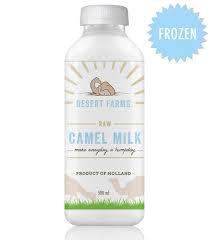
Where to Buy High-Quality Frozen Camel Milk?
In search of frozen camel milk? Camel Milk (Frozen). from Desert Farms is 100% natural milk that is delicately pasteurized while yet retaining all of its nutritional value. The milk has a wonderful, fresh flavor. There are no artificial additives in the product. For more information, visit our official website!
0 notes
Text
Drink Premium Quality Milk In Gurgaon And Stay Healthy
confine our discussion to cow milk. The producers of premium milk in Gurgaon supply milk Milk is one of the best sources to provide many nutrients to the body. It may be calcium, vitamin D, protein, fat, and many other essential elements; all are present in milk. If you want to balance your diet, drinking milk is the best option, along with other foods. Milk sources include cows, buffalos, cattle, camels, and many other domestic animals. You can also get milk from almonds, soy, coconut, hemp, or flax.
It is time to drink premium milk in Gurgaon and stay fit. If your source of milk is from the best dairies in the area, then stay sure to derive all the benefits while drinking. It is time to know the benefits of drinking milk and maintain your health.
The variety of milk from the best diaries
The health benefits of milk will depend on the type of milk you are drinking and the source. Let us with low fat, high protein. It is free from additives that can be harmful to many. The diaries have modern pasteurization machines so that the milk you drink is safe and free from germs, bacteria, and infectious elements.
Again, some of the best diaries in the area produce lactose-free milk with added omega – 3 fatty acids to keep your heart in good condition, reducing triglyceride and cholesterol. You can also drink organic milk free from hormones and avoid consuming unnecessary products while drinking it.
The nutritional benefits
Milk has many nutritional benefits of its own. However, many modern-day milk producers and manufacturers enrich it with specific vitamins. The natural nutrition of milk depends on the fat content. For example, 250 ml of whole premium milk in Gurgaon can contain 3.4 to 3.8% fat producing 149 calories. It can contain 8 grams of fat, 7.5 grams of protein, 275 milligrams of calcium, and 322 mg of potassium. You can also get 3.2 micrograms of vitamin D and 12 grams of sugar.
Again, if you drink skim milk from the best producer, the fat content is low, around 0.2 grams per 250 ml of milk. You will likely get 8.2 grams of protein, 298 mg of calcium, potassium of 381 mg, and 2.9 micrograms of Vitamin D.
You also get magnesium, choline, vitamin A, B 6 12, folate riboflavin, and other nutrients for overall health and wellbeing. While calcium strengthens bones, choline is good for memory, muscle movements, and mood. Again potassium in milk reduces the risk of heart disease, stroke, kidney stones, bone density loss, and high blood pressure. Vitamin D can fight osteoporosis and boost the immune system.
Thus, you can see that drinking good quality milk can enhance bone health and keep brain function more active. It helps control blood pressure and thus lowers the risk of heart ailments. Drinking milk can help you build the muscles in the body and fights against depression. If you are in a weight loss program, drinking milk can boost the process of drinking skimmed milk.
Getting good quality milk
If you look at the munis, the rishis, or even the commoner of yesteryears, you will find they were healthy and glamorous. They enjoyed the gifts of Mother Nature to stay fit. They also drank pure cow milk free from harmful chemicals and unnecessary additives.
People in the dairy business had large goshalas or farms to keep cows, calves, and oxen. The concept remains the same today, but milk producers adopt many modern techniques. However, the best dairy farm producing premium milk in Gurgaon never compromises the psychology of the cows and keeps the calves with their mother. The milk quality becomes inferior when the mother cow is stressed and unable to meet her calf.
Again, the best dairy farms have vast land in their farm so that the cows can have a natural habitat, unlike modern-day cement and concrete farms. However, the milk manufacturers ensure that the cows remain healthy while milking them with modern machines. Some dairies milk some of their cattle by hand, following the traditional method to supply premium quality milk.
Milk manufacturers leave no stone unturned to get and supply the best quality milk. They keep the cattle in the most comfortable and suitable atmosphere amidst nature. After boiling in an iron pot, they also feed the cows with the best quality cotton seeds, jaggery, moth-bean, and fenugreek seeds mixed with mustard oil. These are in addition to the main staple for the cows so that they stay free from infections.
The owners of the best farms go for regular health check-ups of their cattle, taking the services of the best veterinary doctor. They also follow the ancient concept of cattle feeding and treating ailments. They have a superior breed of Indian cows from Gir and Sahiwal on their farm to get high-quality milk and manufacture the best dairy products like ghee and buttermilk.
Take a tour of the farm
If you are skeptical of the claims made by the best manufacturers and producers of premium milk, visiting the farm and taking a tour is best. There is nothing hide and seek by the producers, who will be glad to guide you on their farm so that you can judge their claims. You can ask for the premium milk delivery at your home if you want, and stay assured of the quality. Again, you can consume milk products that undergo processing by following the ancient Vedic methods.
Conclusion
Today more and more people prefer to drink premium milk in Gurgaon for multiple health benefits. It is like going back to nature to stay healthy. Milk is only the most-balanced drink you can have and remain healthy and glamorous for years. Drinking milk is one of many people's secrets to staying fit even at old ages. Drink the best quality milk or eat milk products after sourcing from the best da
0 notes
Text
UAE Dairy Products Market to Surpass USD 2.47 Billion through 2026 | TechSci Research
Increasing demand for flavored and organic dairy products among the UAE population and changing consumer lifestyle are driving the UAE dairy products market towards steady growth.
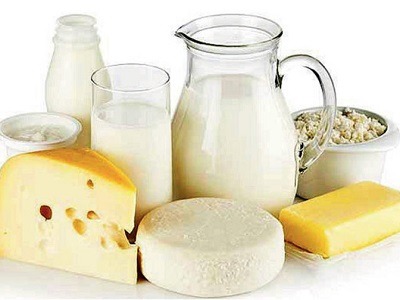
According to TechSci Research report, “UAE Dairy Products Market By Type (Dairy Milk, Ghee & Butter, Ice Cream & Milk Cream, Cheese & Spread, Yogurt, Others), By Distribution Channel (Supermarket /Hypermarket, Grocery Stores, Online & Others), By Region, Competition Forecast & Opportunities, 2026”, the UAE dairy products market stood at USD1.66 billion in 2020 and is projected to reach USD2.47 billion by 2026F with a CAGR of 6.89%. Dairy products, also known as milk products, are types of food which are made from the milk of mammals, most commonly cow, goat, camels, buffaloes, sheep, and other cattle. Dairy products include food items such as milk, cheese and spreads, yogurt, ice cream, milk cream, ghee, butter, and other products like condensed milk cream, pudding, milk powders, etc.
Dairy products market in the UAE is witnessing a tremendous change due to increasing emphasis on nutritional value of dairy products. Introduction of value-added dairy products, changing consumption patterns, growing penetration of international players, etc. are further fueling the growth of dairy products market in the UAE. Value added dairy products, changing consumer preference towards low fat dairy products, increasing per capita spending, etc., are projected to drive the growth of the UAE dairy products market.
The COVID-19 pandemic led to the rise in awareness for healthy eating and drinking habits among the consumers. Thus, a rise in demand for dairy products has been observed across the country post lockdown, as they are considered a healthier option. During and post the pandemic period, the shift in consumers’ focus towards preventive health management practices is expected to drive the growth of the dairy market.
Large players along with the help of the government have established collection and cooling centers in order to manage the storage and distribution of raw milk efficiently. Collection and cooling centers are technologically advanced, where milk can be stored for longer hours at specified locations, and then finally transferred to factories for further processing of dairy products. Moreover, integration of latest technology would enable easy monitoring of cattle health and feeds vis-a-vis limiting human interference. New processing technologies of converting milk into other dairy products with a longer shelf life has reduced losses associated with the perishability of milk and has opened up new markets for surplus milk production.
Browse 20 market data Figures and 6 Tables spread through 84 Pages and an in-depth TOC on "UAE Dairy Products Market"
https://www.techsciresearch.com/report/uae-dairy-products-market/4122.html
The UAE dairy products market consists of the following segments, by type, by distribution channel, by region and by company. In terms of type, the UAE dairy product market is divided into dairy milk, ghee & butter, ice cream & milk cream, cheese & spread, yogurt and others. Among these, dairy milk accounted for the majority of market share in the UAE dairy products market in 2020 followed by cheese and spread. This is due to the rise in awareness of value-added dairy products among consumers, focus on organic milk and growing demand from young population. In terms of distribution channels, the UAE dairy products market is divided into supermarket /hypermarket, grocery stores, online & others. Among these, supermarket /hypermarket accounted for the majority of market share of more than 60% in UAE dairy products market in 2020 and will continue to dominate the market during the forecast period. The online sales segment is the fastest-growing as it is convenient due to better logistic systems.
In terms of region, the UAE dairy products market is divided into Dubai, Abu Dhabi, Sharjah and Rest of UAE. Among which, Dubai has dominated the UAE dairy products market due to the large population and high per capita income. Additionally, dairy products companies in the UAE are continuously focusing on maximizing the dairy farmer investment by creating programs and resources to drive dairy products demand and build consumer confidence to ensure a strong future for the dairy industry in the country. To remain competitive in the market, companies are continuously involved in new product development and in new strategic development.
Some of the leading companies in UAE dairy products market are Almarai Company, Al Rawabi Dairy Co Llc, Al Ain Farms, Gulf & Safa Dairies Co LLC and Marmum Dairy Farm LLC.
Download Sample Report @ https://www.techsciresearch.com/sample-report.aspx?cid=4122
Customers can also request for 10% free customization on this report.
“Dairy products are considered a beneficial source nutrition for preventive healthcare. They are consumed highly in order to maintain a proper health and lifestyle. The growing middle-class population, with rising disposable income, is becoming highly aware of the importance of diet and nutrition for long term good health. Growing awareness about the preventive health among consumers is expected to increase the consumption of dairy products in UAE.”, said Mr. Karan Chechi, Research Director with TechSci Research, a research based global management consulting firm.
“UAE Dairy Products Market By Type (Dairy Milk, Ghee & Butter, Ice Cream & Milk Cream, Cheese & Spread, Yogurt, Others), By Distribution Channel (Supermarket /Hypermarket, Grocery Stores, Online & Others), By Region, Competition Forecast & Opportunities, 2026”, has evaluated the future growth potential of dairy products market in the UAE and provides statistics and information on market structure, size, share and future growth. The report is intended to provide cutting-edge market intelligence and help decision makers take sound investment decision. Besides, the report also identifies and analyzes the emerging trends along with the essential drivers, challenges and opportunities present in the UAE dairy products market.
BROWSE RELATED REPORTS:
United States Yogurt Market By Type (Non-Flavored, Flavored), By Fat Content, (Regular, Low Fat, Fat-Free), By Form (Conventional Yogurt, Set Yogurt, Greek Yogurt, Frozen Yogurt, Yogurt Drinks and Others), By Packaging (Pouches, Plastic Bottles, Tetra Packs and Others), By Distribution Channel (Convenience Stores, Independent Small Grocers, Supermarket/Hypermarket, Online Channel), By Region, Competition, Forecast & Opportunities, 2026
https://www.techsciresearch.com/report/united-states-yogurt-market/7330.html
United States Wheat Protein Market, By Product (Wheat Gluten, Textured Wheat Protein, Wheat Protein Isolate and Hydrolysed Wheat Protein), By Application (Bakery & Snacks, Pet Food, Processed Meat, Meat Analogs, Nutritional Bars & Drinks and Others), By Form (Dry and Liquid), By Company and By Geography, Forecast & Opportunities, 2026
https://www.techsciresearch.com/report/united-states-wheat-protein-market/3016.html
United States Milk Protein Market by Type (Milk Protein Concentrates, Milk Protein Isolates and Others), By Application (Sports Nutrition, Infant Formula, Dairy Products and Others), By Functionality (Emulsification, Foaming & Thickening and Others), By Processing Method (Pasteurization, Creaming & Homogenization and Others), By Livestock, By Form, By Company and By Geography, Forecast & Opportunities, 2026
https://www.techsciresearch.com/report/united-states-milk-protein-market/3123.html
About TechSci Research:
TechSci Research is a leading global market research firm publishing premium market research reports. Serving 700 global clients with more than 600 premium market research studies, TechSci Research is serving clients across 11 different industrial verticals. TechSci Research specializes in research-based consulting assignments in high growth and emerging markets, leading technologies and niche applications. Our workforce of more than 100 fulltime Analysts and Consultants employing innovative research solutions and tracking global and country specific high growth markets helps TechSci clients to lead rather than follow market trends.
Contact
Mr. Ken Mathews
708 Third Avenue,
Manhattan, NY,
New York – 10017
Tel: +1-646-360-1656
Email: [email protected]
Website: https://www.techsciresearch.com/
For More Market Research Blogs Visit: https://techsciblog.com/
#TechSci#Market Research Reports#UAE Dairy Products Market#Consumer#Dairy Products Market#UAE Dairy Products Market Size#Dairy Products#UAE Dairy Products Market Forecast
0 notes
Text
Camel Milk Market Unidentified Segments - The Biggest Opportunity Of 2022
Latest edition released by AMA on Global Camel Milk Market to regulate the balance of demand and supply. This intelligence report on Camel Milk includes Investigation of past progress, ongoing market scenarios, and future prospects. Data True to market on the products, strategies and market share of leading companies of this particular market are mentioned. It’s a 360-degree overview of the global market’s competitive landscape. The report further predicts the size and valuation of the global market during the forecast period. Some of the key players profiled in the study are
Camelicious (United Arab Emirates)
Al Ain Dairy (United Arab Emirates)
Desert Farms (United States)
Vital Camel Milk (Kenya)
Tiviski Dairy
Camilk Dairy (Australia)
Camel Dairy Farm Smits (Netherlands)
Camel Milk Co (Australia)
Camel Milk (South Africa)
Amul (India) Camel milk contains high concentrations of potassium, magnesium, copper, sodium, zinc, iron, B vitamins, vitamins C. It also contains protective proteins such as Lysozymes, Lactoferrin, Peptidoglycan recognition protein, and NAGase. According to the Australian camel industry association, it has five times the vitamin C and 10 times the iron of cow’s milk. Camel milk also comes in raw, pasteurized and powdered form which is used to make a product like soap. Market Trends: Increasing Demand in United States as Alternative Milk for Health Benefits
Opportunities: Great Opportunity for Camel Dairies in Australia Because Of Its Incredible Reputation in Food Quality Safety Standards
Market Drivers: Increasing Awareness of Health Benefits
Emerging Countries for Camel Milk
Investments to Expand Australian Camel Milk Production
Presented By
AMA Research & Media LLP
0 notes
Text
UAE Dairy Products Market to Surpass USD 2.47 Billion through 2026 | TechSci Research
Increasing demand for flavored and organic dairy products among the UAE population and changing consumer lifestyle are driving the UAE dairy products market towards steady growth.
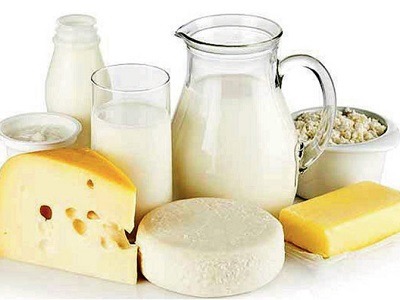
According to TechSci Research report, “UAE Dairy Products Market By Type (Dairy Milk, Ghee & Butter, Ice Cream & Milk Cream, Cheese & Spread, Yogurt, Others), By Distribution Channel (Supermarket /Hypermarket, Grocery Stores, Online & Others), By Region, Competition Forecast & Opportunities, 2026”, the UAE dairy products market stood at USD1.66 billion in 2020 and is projected to reach USD2.47 billion by 2026F with a CAGR of 6.89%. Dairy products, also known as milk products, are types of food which are made from the milk of mammals, most commonly cow, goat, camels, buffaloes, sheep, and other cattle. Dairy products include food items such as milk, cheese and spreads, yogurt, ice cream, milk cream, ghee, butter, and other products like condensed milk cream, pudding, milk powders, etc.
Dairy products market in the UAE is witnessing a tremendous change due to increasing emphasis on nutritional value of dairy products. Introduction of value-added dairy products, changing consumption patterns, growing penetration of international players, etc. are further fueling the growth of dairy products market in the UAE. Value added dairy products, changing consumer preference towards low fat dairy products, increasing per capita spending, etc., are projected to drive the growth of the UAE dairy products market.
The COVID-19 pandemic led to the rise in awareness for healthy eating and drinking habits among the consumers. Thus, a rise in demand for dairy products has been observed across the country post lockdown, as they are considered a healthier option. During and post the pandemic period, the shift in consumers’ focus towards preventive health management practices is expected to drive the growth of the dairy market.
Large players along with the help of the government have established collection and cooling centers in order to manage the storage and distribution of raw milk efficiently. Collection and cooling centers are technologically advanced, where milk can be stored for longer hours at specified locations, and then finally transferred to factories for further processing of dairy products. Moreover, integration of latest technology would enable easy monitoring of cattle health and feeds vis-a-vis limiting human interference. New processing technologies of converting milk into other dairy products with a longer shelf life has reduced losses associated with the perishability of milk and has opened up new markets for surplus milk production.
Browse 20 market data Figures and 6 Tables spread through 84 Pages and an in-depth TOC on "UAE Dairy Products Market"
https://www.techsciresearch.com/report/uae-dairy-products-market/4122.html
The UAE dairy products market consists of the following segments, by type, by distribution channel, by region and by company. In terms of type, the UAE dairy product market is divided into dairy milk, ghee & butter, ice cream & milk cream, cheese & spread, yogurt and others. Among these, dairy milk accounted for the majority of market share in the UAE dairy products market in 2020 followed by cheese and spread. This is due to the rise in awareness of value-added dairy products among consumers, focus on organic milk and growing demand from young population. In terms of distribution channels, the UAE dairy products market is divided into supermarket /hypermarket, grocery stores, online & others. Among these, supermarket /hypermarket accounted for the majority of market share of more than 60% in UAE dairy products market in 2020 and will continue to dominate the market during the forecast period. The online sales segment is the fastest-growing as it is convenient due to better logistic systems.
In terms of region, the UAE dairy products market is divided into Dubai, Abu Dhabi, Sharjah and Rest of UAE. Among which, Dubai has dominated the UAE dairy products market due to the large population and high per capita income. Additionally, dairy products companies in the UAE are continuously focusing on maximizing the dairy farmer investment by creating programs and resources to drive dairy products demand and build consumer confidence to ensure a strong future for the dairy industry in the country. To remain competitive in the market, companies are continuously involved in new product development and in new strategic development.
Some of the leading companies in UAE dairy products market are Almarai Company, Al Rawabi Dairy Co Llc, Al Ain Farms, Gulf & Safa Dairies Co LLC and Marmum Dairy Farm LLC.
Download Sample Report @ https://www.techsciresearch.com/sample-report.aspx?cid=4122
Customers can also request for 10% free customization on this report.
“Dairy products are considered a beneficial source nutrition for preventive healthcare. They are consumed highly in order to maintain a proper health and lifestyle. The growing middle-class population, with rising disposable income, is becoming highly aware of the importance of diet and nutrition for long term good health. Growing awareness about the preventive health among consumers is expected to increase the consumption of dairy products in UAE.”, said Mr. Karan Chechi, Research Director with TechSci Research, a research based global management consulting firm.
“UAE Dairy Products Market By Type (Dairy Milk, Ghee & Butter, Ice Cream & Milk Cream, Cheese & Spread, Yogurt, Others), By Distribution Channel (Supermarket /Hypermarket, Grocery Stores, Online & Others), By Region, Competition Forecast & Opportunities, 2026”, has evaluated the future growth potential of dairy products market in the UAE and provides statistics and information on market structure, size, share and future growth. The report is intended to provide cutting-edge market intelligence and help decision makers take sound investment decision. Besides, the report also identifies and analyzes the emerging trends along with the essential drivers, challenges and opportunities present in the UAE dairy products market.
BROWSE RELATED REPORTS:
United States Yogurt Market By Type (Non-Flavored, Flavored), By Fat Content, (Regular, Low Fat, Fat-Free), By Form (Conventional Yogurt, Set Yogurt, Greek Yogurt, Frozen Yogurt, Yogurt Drinks and Others), By Packaging (Pouches, Plastic Bottles, Tetra Packs and Others), By Distribution Channel (Convenience Stores, Independent Small Grocers, Supermarket/Hypermarket, Online Channel), By Region, Competition, Forecast & Opportunities, 2026
https://www.techsciresearch.com/report/united-states-yogurt-market/7330.html
United States Wheat Protein Market, By Product (Wheat Gluten, Textured Wheat Protein, Wheat Protein Isolate and Hydrolysed Wheat Protein), By Application (Bakery & Snacks, Pet Food, Processed Meat, Meat Analogs, Nutritional Bars & Drinks and Others), By Form (Dry and Liquid), By Company and By Geography, Forecast & Opportunities, 2026
https://www.techsciresearch.com/report/united-states-wheat-protein-market/3016.html
United States Milk Protein Market by Type (Milk Protein Concentrates, Milk Protein Isolates and Others), By Application (Sports Nutrition, Infant Formula, Dairy Products and Others), By Functionality (Emulsification, Foaming & Thickening and Others), By Processing Method (Pasteurization, Creaming & Homogenization and Others), By Livestock, By Form, By Company and By Geography, Forecast & Opportunities, 2026
https://www.techsciresearch.com/report/united-states-milk-protein-market/3123.html
About TechSci Research:
TechSci Research is a leading global market research firm publishing premium market research reports. Serving 700 global clients with more than 600 premium market research studies, TechSci Research is serving clients across 11 different industrial verticals. TechSci Research specializes in research-based consulting assignments in high growth and emerging markets, leading technologies and niche applications. Our workforce of more than 100 fulltime Analysts and Consultants employing innovative research solutions and tracking global and country specific high growth markets helps TechSci clients to lead rather than follow market trends.
Contact
Mr. Ken Mathews
708 Third Avenue,
Manhattan, NY,
New York – 10017
Tel: +1-646-360-1656
Email: [email protected]
Website: https://www.techsciresearch.com/
For More Market Research Blogs Visit: https://techsciblog.com/
#TechSci#Market Research Reports#UAE Dairy Products Market#Dairy Products#ConsumerandRetail#Consumer#Dairy Products Market#UAE Dairy Products Market Size#UAE Dairy Products Market Forecast
0 notes